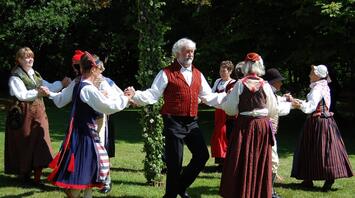The mystical pagan traditions still celebrated in Sweden at Midsummer

Swedish Midsummer, celebrated annually on the Friday between June 19 and 25, is a time-honored festival that marks the summer solstice with vibrant pagan customs deeply woven into the country’s cultural tapestry. Families and friends eagerly anticipate this day, often spending it at summer cottages nestled in picturesque countryside settings—a quintessential Swedish experience. These cottages, adorned with traditional red-painted exteriors and surrounded by lush fields or coastal views, epitomize the idyllic backdrop for Midsummer celebrations.
At the heart of Midsummer festivities is the maypole, adorned with birch leaves and wildflowers, symbolizing fertility and the vitality of nature. The day kicks off with the raising of this maypole, followed by joyous dancing and singing traditional songs, often accompanied by the clinking of snaps glasses—a strong alcoholic drink that adds to the jovial atmosphere. Among the most beloved dances is the playful "Little Frogs" dance, where participants mimic amphibians with spirited leaps and quirky movements, a whimsical nod to Swedish folklore.
The culinary aspect of Midsummer is equally rich. A traditional Midsummer lunch, known as the smorgasbord, features an array of delicacies: pickled herring, dill-seasoned new potatoes, smoked salmon, cheese quiches, meatballs, and the quintessential dessert of strawberries and whipped cream. This feast celebrates the bounty of the season and is complemented by Aquavit, a traditional Swedish spirit enjoyed during festive occasions.
Midsummer's roots trace back to Norse pagan times when the summer solstice was a momentous event, believed to imbue plants with potent healing powers and offering glimpses into the mystical realm. Even today, young women continue the tradition of placing seven types of wildflowers under their pillows to dream of their future spouses, symbolizing rebirth and fertility.
In Stockholm, the celebrations at Skansen, the world’s oldest open-air museum, are particularly grand. Here, visitors can partake in wreath-making workshops, witness the ceremonial raising of the maypole, and join in lively folk dances performed in colorful regional costumes. The festive ambiance, accompanied by traditional music played on fiddles and key harps, draws thousands of locals and international visitors alike.
Beyond Sweden's borders, Swedish expatriates in cities like London and New York uphold Midsummer traditions with gatherings in parks and restaurants. These events, marked by flower garlands, live music, and communal joy, serve not only as a homage to Swedish heritage but also as a bridge connecting cultures.
Midsummer remains a cherished occasion in Sweden, blending ancient pagan rituals with contemporary revelry, making it a testament to the enduring cultural legacy of the Swedish people.



















